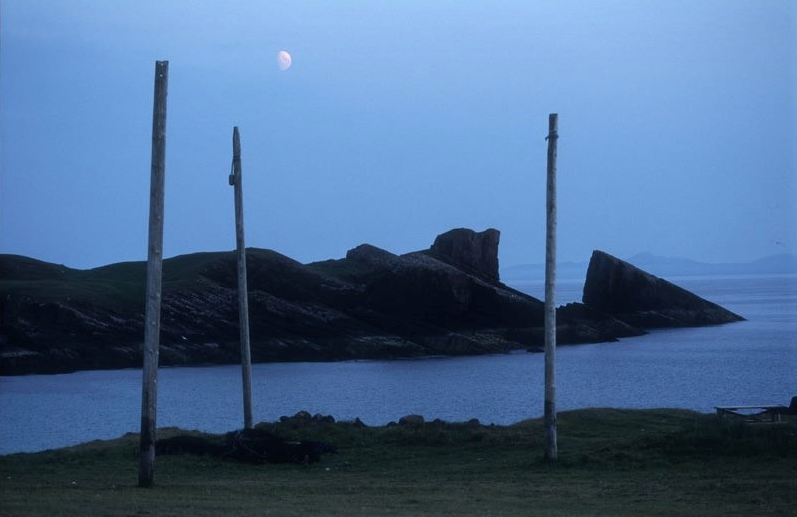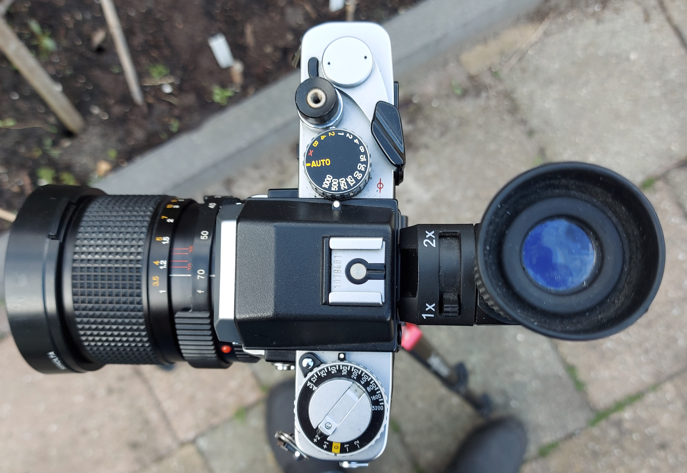Sometimes I work from a tripod because circumstances dictate a long exposure time. That actually makes sense.
And sometimes, I work from a tripod because I find that this forces me into a different, slower, more dedicated mode of photography. The mere act of getting the camera on a tripod apparently slows me down, and this creates space for me to pay more attention, which mainly goes into composition and proper, careful exposure.
Isn’t that a crutch?
Yes, I’m pretty sure it is. And I’ll use all the help I can get.
One thing is that, when I shoot without a tripod, I’ll usually work from eye level — standing up. That’s not always the best perspective. Using a tripod makes me think more about what camera height gives me the best perspective for that particular image I want to create.
You might think that would make me get into an uncomfortable position to be able to peer from the viewfinder, but that’s where the angle finder comes in. More on that later!
Understood. So what about the tripod zen…?
At a certain point, I found out that most of my really good shots were made off a tripod — and most of these were uncropped! When I shoot “from the hip”, so to speak, I apparently get some stuff in the frame that I shouldn’t have included in the first place, so I crop that out later… but when I shoot off a tripod, I apparently take enough care to make sure I have the composition right before engaging the shutter.

Minolta XM with waist level finder, MC-Rokkor 58/f1.2, Fuji Velvia, Velbon Neo Camargue carbon tripod.
Exposed with incident metering. Time spent taking this photo: approx. 15 minutes.
Since I’ve been slowed down anyway, paying proper attention to the scene and determining how to expose it comes fairly naturally. I’ve been raised to shoot on film, and I still do that a lot, and the lack of the ability to “chimp” (to examine the picture on the display, and look at the histogram, right there and then) does wonders for your determination to get that shot exactly right. On a tripod, I’ll usually go off auto-exposure, and either use incident metering, or grab a spot meter to expose for the shadows — a method I grew up with, was subsequently educated in, and which I know how to apply.
Mind you, I’m not saying this makes my photos better. Quite often, when, out of curiosity, I check my own assessment against what the auto-exposure would come up with, it turns out it agrees with my assessment. Shooting Minoltas (who sorted their honeycomb pattern metering systems out centuries ago, or so it seems) does that to you.
The main thing about shooting off a tripod is that it allows you to slow down and pay more attention to whatever it takes to get good photos. Shooting “from the hip” is just that… for me at least.
The angle finder
This is an accessory that I should, and will, make sure is always in my camera bag. It’s an extremely useful accessory for all my cameras — indispensable for all of them except for the Sony A77, which has live view.
Apparently, Seagull figured out that it was selling it too cheap, as by now, it has doubled in price, but at 50 bucks, it’s still worth every penny.
I bought my current angle finder some twelve years ago, for use on the Sony A900 which I had gotten a year earlier… and it turns out that it fits all my Minoltas, from the SR-T101 up to and including the Dynaxes and the Sony digitals.
Minolta sold their own angle finders, but I’m pretty sure these were made by Seagull, a Chinese camera and optics manufacturer to whom Minolta outsourced at least the manufacturing of the X300 and some optics as well. Mine carries the Seagull logo, and it cost me about 50% of what I would’ve paid for the same angle finder with the Minolta logo on it. Google it!
So, then what is it that makes this angle finder so useful?
First of all, it greatly reduces discomfort (and the resulting stress) when trying to peer through a viewfinder that is not at eye level. Lying on your belly on wet cobblestones does wonders for your unwillingness to spend much time in that position, and tilting your head backwards to be able to more or less peer through the viewfinder even more. It’ll give cramps, cut off blood supply, and make accurate manual focusing harder than you would think, especially when the light conditions are less than optimal.
The angle finder fixes that. And yes, you can rotate the tube 360° so that you can also use it in portrait mode, or even if the camera is upside down.

The Seagull angle finder has another very helpful feature — as you can see in the above picture, it can magnify the finder picture to 2x magnification, thus making manual focusing even easier.
[EDIT: for those of us who wear glasses]
I happen to have a +1.25 prescription, as well as a reading addition, in my viewfinder eye.
While my Dynaxes and my Sony digitals come with a diopter correction facility, the older Minoltas don’t have that, and finding a plus diopter correction lens is… not easy.
But the Seagull angle finder (like most others, as I would think) have a built-in correction with a very good range! On the Dynaxes, I have to dial in maximum plus correction, but on the angle finder, I’ve got plenty to spare. And if I’m going to work from a tripod and use the angle finder, taking my glasses off and have a clear, tack-sharp, unobstructed view through the viewfinder is small effort, and a blissful experience.
I’m serious — if you have a 35mm camera with a classic finder (as in, not a waist level finder), and you get an angle finder, chances are you’ll wonder how you ever did without.

Danny 2022-04-12
I bought a second hand Seagull angle finder that was missing some bits, but, it was fine on my camera. Then I got a new camera that needed a different eyepiece connector that I didn’t have. I wrote to seagull asking if I could buy the missing bit, they sent me a complete finder free! Excellent company and a good product.
admin 2022-04-12 — Post Author
Wow!
Did you write to Seagull in China? I’ve never done any business with them directly — my angle finder came from… I think Amazon.
But I would expect them to have good products; I think Minolta farmed out some work to them, at least during the X300 days.
As a sidenote: You may have noticed that I’m not in the Minolta Film Cameras group anymore. This morning, I noticed that someone who harbours some sort of grudge towards me was recently made moderator, and decided to come after me with his mod cap on. It is my experience that no good will come of that… so I left.
Side note 2: I forgot that another very convenient feature of the Seagull angle finder is that it allows you to adjust the diopter. I will edit the text accordingly within 5 minutes from now.